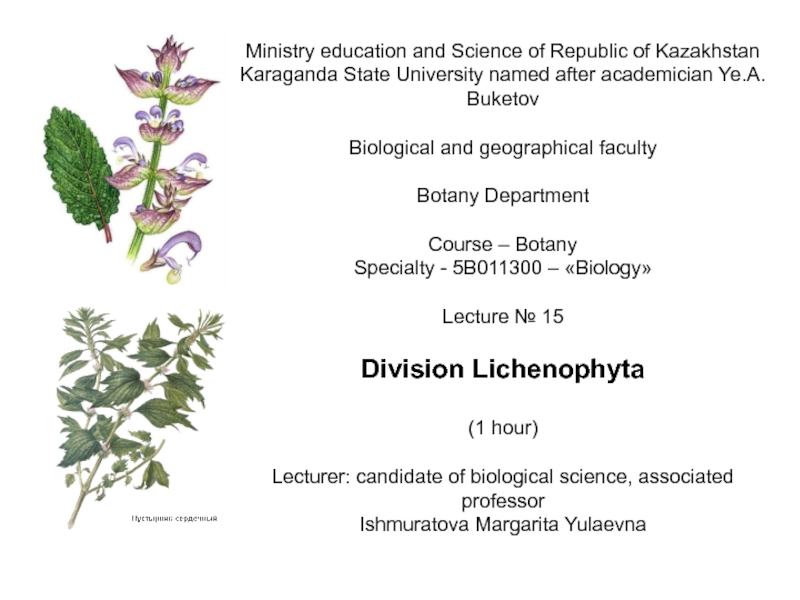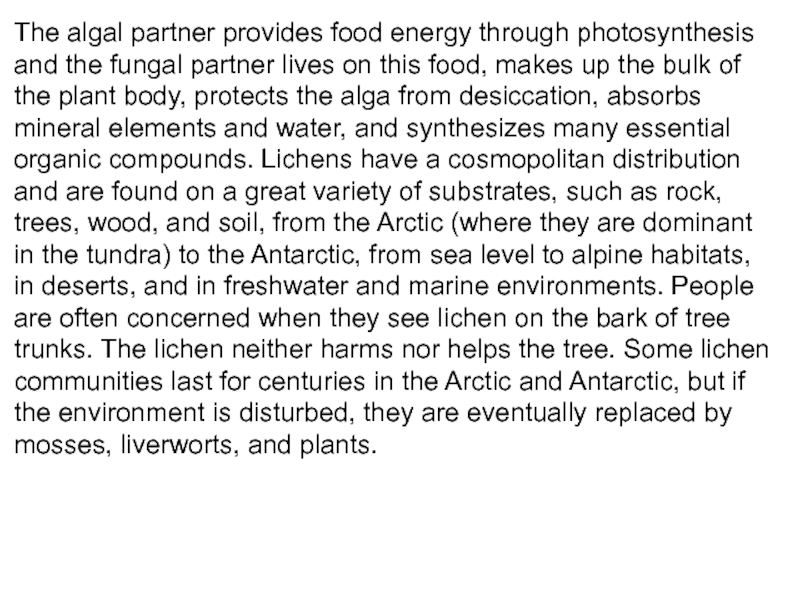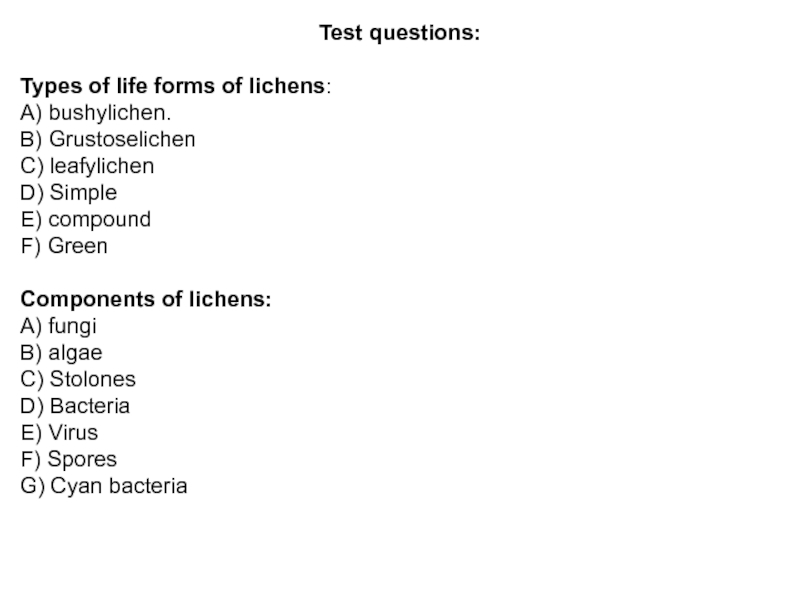Слайд 1Ministry education and Science of Republic of Kazakhstan
Karaganda State University
named after academician Ye.A. Buketov
Biological and geographical faculty
Botany Department
Course – Botany
Specialty - 5В011300 – «Biology»
Lecture № 15
Division Lichenophyta
(1 hour)
Lecturer: candidate of biological science, associated professor
Ishmuratova Margarita Yulaevna
Слайд 2Plan of lecture:
1 General characteristic of lichens – as the
symbiotic organisms.
2 Peculiarities of anatomical structure of lichens.
3 Growth and
nutrition of lichens.
Слайд 3Basic literatures:
1 Еленевский А.Г., Соловьев М.П., Тихомиров В.Н. Ботаника:
систематика высших, или наземных, растений. 2 изд. - М.: Academіa,
2001. - 429 с.
2 Нестерова С.Г. Лабораторный практикум по систематике растений. - Алматы: Қазақ ун-ті, 2011. - 220 с.
3 Родман А.С. Ботаника. – М.: Колос, 2001. - 328 с.
Additional literatures:
1 Абдрахманов О.А. Систематика низших растений. – Караганда: Изд-во КарГУ, 2009. - 188 с.
2 Билич Г.Л., Крыжановский В.А. Биология. Т. 2: Ботаника. - М.: Оникс 21 век, 2002. - 543 с.
3 Абдрахманов О.А. Практические работы по систематике низших растений. Ч. 2. Грибы и водоросли. – Караганда: Изд-во КарГУ, 2001. - 144 с.
4 Абдрахманов О.А. Лабораторный практикум по бактериям и водорослям. Учебное пособие. - Алматы: Казакадем образование, 2000. - 130 с.
5 Абдрахманов О.А. Практические работы по систематике низших растений. Ч. 2. Грибы и водоросли. – Караганда: Изд-во КарГУ, 2001. - 144 с.
6 Абдрахманов О.А., Айдарханова Г.С. Лихенология. – Алматы, 2003. - 167 с.
Слайд 4Division Phycomycota (Lichenes).
Lichens
-combination of green algae and fungus -classified
by fungus species -the two organisms exist in mutualistic relationship:
both benefit -algae: photosynthesis to synthesize organics to feed both -fungi: holdfast, & protection from desiccation -together can survive in environments where neither would survive alone - often first and only life forms to colonize newly exposed rock, slow growing -lichens (fungal part) degrade rock to produce soil for plants -lichen serves as food for animals.
Слайд 5The algal partner provides food energy through photosynthesis and the
fungal partner lives on this food, makes up the bulk
of the plant body, protects the alga from desiccation, absorbs mineral elements and water, and synthesizes many essential organic compounds. Lichens have a cosmopolitan distribution and are found on a great variety of substrates, such as rock, trees, wood, and soil, from the Arctic (where they are dominant in the tundra) to the Antarctic, from sea level to alpine habitats, in deserts, and in freshwater and marine environments. People are often concerned when they see lichen on the bark of tree trunks. The lichen neither harms nor helps the tree. Some lichen communities last for centuries in the Arctic and Antarctic, but if the environment is disturbed, they are eventually replaced by mosses, liverworts, and plants.
Слайд 6Lichens are very sensitive to air pollution, and different species
are affected by different concentrations of specific air pollutants. Thus,
it is frequently possible to estimate the level of air pollution in an area by determining the kinds and/or numbers of lichens that are present.
Слайд 10Peculiarities of anatomical structure of lichens
Heteromery (А) and homeomery
lichens (Б)
Слайд 12Lichens produce much polysaccharides, and few proteins and fats. Some
chemical compounds of lichens have anti-bacterial activity. Such lichens, as
cladonia, parmelia, evernia, are used for production of antibiotics, essential oil, aromatic compounds and paints.
Слайд 14Control questions:
1 Make a characteristic of place of location
of lichens.
2 Which type of nutrition are used lichens?
3 Why
lichens are symbiotic organisms?
4 Which components are present inside lichens?
5 Determine role of lichens for human and nature.
Слайд 15Test questions:
Types of life forms of lichens:
A) bushylichen.
B) Grustoselichen
C) leafylichen
D)
Simple
E) compound
F) Green
Components of lichens:
A) fungi
B) algae
C) Stolones
D) Bacteria
E) Virus
F) Spores
G) Cyan bacteria


































